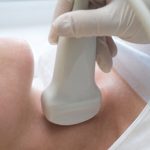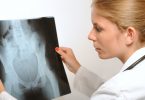Most malignancies of the breast begin with a mass in the area, usually felt as a new lump. Inflammatory breast cancer often presents very differently. In this rare type of malignancy, the cancer cells do not form a palpable lump. They are often discovered when the cells block lymph vessels and cause swelling.
Also known as IBC, this is one of the rarest types of malignancies, just one to five percent of all cancers of the breasts. It is more aggressive and can be more deadly than other kinds as well, with a 40% five year survival rate. This high mortality rate is partially due to its atypical presentation, with many people not realizing they have a problem until the disease is in advanced stages.
Symptoms
Most women look for malignancy by checking for a lump or mass. IBC presents very differently. Women usually notice the following symptoms:
- Discoloration of a patch of skin on the breast. Changes in the color of the skin are often one of the earliest signs of an inflammatory malignancy. Suddenly a small patch of skin on the chest appears red, purple, or another unusual color. These changes often resemble a bruise but they do not fade. Any bruise that arises without an injury and does not resolve on a normal time scale should be suspect.
- Chest pain. Pain in the wall of your chest or in your tissues may be the first sign of a dangerous disease such as this one. Because the disease is inflammatory, you may develop an area of warmth and/or tenderness as one of the first signs. This will be especially noticeable when you try to lie on your stomach or when you are performing activities that jostle your tissues, such as jogging. Wearing a bra may even become uncomfortable.
- Dimpled skin. Inflammatory types of disease will cause a distinctive look to the skin that is often called “peau d’orange,” or orange peel. The skin will become firm and have small dimples or pits, resembling the peel of an orange.
- Changes in your nipples. One of the earliest signs of inflammatory cancers is often changes in the nipples. They may become more flattened or retract inside the other tissue. Many women naturally have flat or retracted nipples, but new changes should always be treated as a potential bad sign. The nipples also may become itchy or otherwise feel differently than before.
- Rapid changes in size. Most women will notice that their breasts change size as they age, as they change weight, and as they undergo other changes in health. These changes are usually not concerning and generally happen slowly. In the case of cancers, however, the change in size will be dramatic and rapid. Inflammation can cause swelling that increases size rapidly or even decreases it. The easiest way to tell it from normal changes in size is that inflammation will cause breasts to change size in a very asymmetric, one-sided manner.
- Lymph node swelling. Many cancers can affect the lymph nodes, including this one. You may notice that you have swollen lumps in your armpit or above your collarbone. These are usually not painful. Cancerous cells can quickly spread throughout the body, a process known as metastasis, once they are in the lymph system. If you notice any changes in your lymph nodes, see a physician as soon as possible.
More from Things Health
-
What is Cancer and How Does It Work?
We all know what cancer is, but understanding how it works and why people get cancer at all can be confusing. Cancer starts when cells…
-
Thyroid Cancer
Each type requires a different kind of prognosis and treatment. This is the most typical type of thyroid cancer, it can make up about 80%…
-
Symptoms Of Ovarian Cancer
Ovarian cancer is often referred to as a quiet disease as it usually isn't discovered until it is in the advanced phases. In nearly all…
-
Symptoms Of Prostate Cancer
Cancer of the prostate affects more than 200,000 men each year in the US alone. Worldwide statistics for prostate cancer continue to grow tremendously, and…
-
Types Of Skin Cancer
Skin cancer happens when skin cells are damaged, for instance, by overexposure to ultraviolet rays from the sun. Melanoma - the most dangerous type of…


















